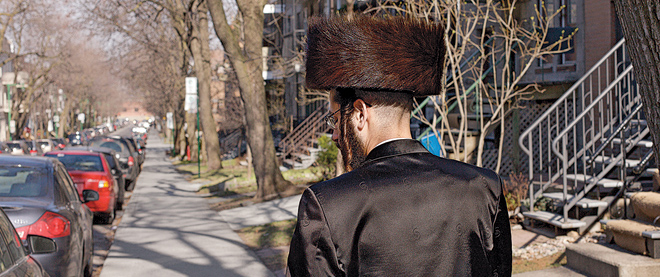Outremont’s unholy mess
A long-brewing fight over accommodating Hasidim turns ugly
Share

Pierre Lacerte rarely leaves his house without a sense of righteous indignation, and never without his point-and-shoot camera holstered on his belt. When he walks through his neighbourhood of Outremont in Montreal, he may take a picture, or seven, of garbage-strewn yards, illegal construction, parking infractions, oversized buses, unlicensed gatherings and any other infraction allegedly committed by the area’s Hasidic Jewish community.
The pictures are fodder for his blog, a mean-spirited take on his Hasidic neighbours and the politicians he says “are on all fours in front of the Hasidim.” Liberal politician Martin Cauchon becomes “Martin Kosher”; Montreal Mayor Gérald Tremblay is blasted for courting the Hasidic vote during the last election, or “electorah.” Lacerte also attends municipal council meetings with near-religious fervour out of a sense of “exasperation” with the Hasidim, who he believes are making Outremont unbearable for the goyim. “I’m determined, not obsessed,” he said recently from a croissanterie near his home. “They’re a small minority, and already it’s a mess. What’s it going to be like in 15 years when they have doubled in size?”
Lacerte’s diatribes are indicative of the mood in Outremont. The arrondissement of choice for Quebec’s cultural and political elite is synonymous with sidewalk cafés and quiet power. Yet it has in recent years been the scene of a debate over how much leeway should be given to its religious minorities. Many residents think they know the answer: not much. Not any, actually. “Some people just want to make life miserable for the Jews,” says Alex Werzberger, the Hasidic leader frequently parodied on Lacerte’s site.
It has been ugly as of late. In March, anonymous leaflets appeared on lampposts and parking meters decrying an “illegal synagogue” in neighbouring Mile End, and urging Outremont residents to call elected officials to protest. (The building is used as a temporary meeting place for young Hasidic men, Werzberger says.) Then, a couple of weeks ago, vandals broke into an Outremont synagogue and drew swastikas on its bimah, or pulpit.
Council meetings, meanwhile, have become pitched battles between pro- and anti-Hasid camps. Recently, police removed Giselle Lafortune, a 74-year-old retired beautician and vocal critic of the Hasidim, from a meeting for repeated disruptions. Lafortune says police intervened after she called Hasidic spokesperson Meyer Feig a racist, but only after Feig insulted the upbringing of non-Hasidic children. (Feig couldn’t be reached for comment.) “I don’t want it to be like this, but it’s becoming a place where one community is pitted against another,” says Outremont Mayor Marie Cinq-Mars.
Tensions go back a few years. In the late 1990s Hasidim challenged a bylaw preventing them from erecting an eruv, a series of strings hung around a neighbourhood allowing the observant to perform otherwise verboten functions on the sabbath. The eruv, councillor Céline Forget said at the time, would prevent her from flying a kite outside her home. (The bylaw was struck down.) “You see where they’re coming from,” Werzberger says of his critics. Bylaw issues are a smokescreen, he says, for hatred of what amounts to a very visible minority. “They’re scared of what happens as we get bigger, and what will happen if we elect someone to municipal council.”
Not so, says Forget. The battle over bylaws is important, she says, if Outremont is to be Outremont and not what Lacerte calls a “religious ghetto.” In 1999, she successfully lobbied the courts to close down an illegal synagogue; opening synagogues in residential areas, then annexing surrounding buildings, is the ultimate goal of the Hasidim, she says. During the court proceedings, she was assaulted and her home vandalized.
It would have been difficult to fathom such rancour 50 years ago. Roughly 30 Hasidic families arrived from Europe after the Second World War. Attracted by its quiet streets and plentiful housing, they settled in and around Outremont, building synagogues and, much like their French Catholic brethren, reproducing copiously. Outremont practised reasonable accommodations well before it became a catchphrase: according to Cinq-Mars, there has been an unwritten rule for 40 years that says snow removal is “avoided” on certain streets on the Jewish Sabbath.
But as Quebec society became more secular and less fecund, the Hasidic community continued to grow, and to practise a brand of Judaism emphasizing piety, prayer and a certain detachment from non-Hasidim—echoes of the fight over the niqab, the Islamic veil that is Quebec’s perceived threat du jour. The friction was only a matter of time and demographics: today, Hasidim represent 20 to 25 per cent of Outremont’s population of 97,000. For some, their garb—black coats, long dresses and payos braids—is as obvious as their downturned eyes as they walk the streets. “They want to control the environment,” Forget says. “That’s why they live so close together. They think when they control a street they can apply their own rules.”
Not every Outremonter agrees. Kaitlin Jones lives down the street from Lacerte. Sure, her neighbours occasionally hiss at her bare flesh and copious tattoos. “You get over it. I mean, Outremont’s the safest neighbourhood I’ve ever lived in,” she says. The double parking? The loud synagogues? “It’s part of living in Montreal. You’re going to inconvenience someone at some point.”